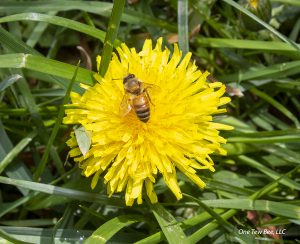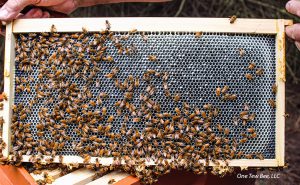Hey beekeepers, it’s perfectly normal.
By: James E. Tew
Beekeepers slowly grow to accept the obvious
If you read any bee book, beekeeping is made to look precise – predictable. In reality, it is anything but. Through the passing decades, innumerable times, new beekeepers have plaintively cried to me (and you), “I put on the supers, but they didn’t use them.” “I removed the cork, but the bees still have not released the queen from that little cage thingy.” “I put on a feeder, but the bees didn’t take the syrup.” Or “I put on another brood chamber, but they still swarmed.”
Bee management is not precise. It never was. When we are new beekeepers, we try to treat the craft with precision, but we are continually rebuffed by the bees and the decisions that they make on their own. The book says, “Do these things, in this order, and your bees will be fine – most of the time.” Over time, the ever-evolving beekeeper begins to accept the ambiguity of the craft. Whatever common management procedure that we are doing is probably the right thing to do – most of the time. Our general management recommendations are always best guesses. They always have been.
But still, we never miss an opportunity
Colonies on scales
But we never miss an opportunity to try to add some precision to our management systems. Scale colonies and their related apps are a great example. You can tell a lot from what is happening with a colony that is on weight scales. Scale colonies’ data yields actual numbers. You can tell when a nectar flow is ongoing and when surplus honey is being stored. But you are only recording what happened either by natural forces or by bees making their own survival decisions. We’re not really controlling anything. “Well, it was a cold, wet Spring this year. The bees are late.” “Humm, clover is in full bloom. Why are the bees not putting up more crop?”
In this case, data gathered from the scale colony helps us improve our future guesses – but they are still just numerical estimations. Just so you know, I heartedly support the use of scale colonies or other weighing devices on some of our colonies. Even though they are still estimations, over time, scale weight data significantly improved our ability to predict and schedule future management events.
Requeen regularly
Change the queen on a regular basis. Yeah, right! That’s in every general bee book seemingly ever published. It’s a common recommendation made by authors who will not be paying for the replacement queens or installing them. Even so, the perpetual recommendation has been to requeen every other year. Apparently, the prevailing opinion is that a new queen will not swarm during her first year on the job, and the bees will not be superseding during the nectar flow (Personally, I have commonly had late season swarms from packages or splits that outgrew their brood nest areas. I am reasonably comfortable writing that if the brood area is consistently crowded, even a first year queen cannot suppress the swarming characteristic within the colony. In earlier articles, I whimsically referred to these late swarms as suicide swarms. They had no chance of surviving the upcoming Winter. But oddly, the parent colony was going to face extreme challenges, too, in getting the new queen mated so late in the season. I offer the comment here that these late season swarms are truly bad for the general survival of both the swarm and the parent colony. Why would a colony do this?).
So, do you see? As bee managers, we try to get ahead of this swarming/superseding thing by requeening every other year. In textbook beekeeping, the replaceable queen is probably already doing a marginal job and needs to be replaced. In yet other textbook beekeeping worlds, queens are readily available and are affordable. Importantly, in the perfect world of textbook beekeeping, hypothetically, I am an accomplished bee colony manager, and I am able to perform this queen-replacement event with confidence and certainty. So, do you see? We put a specific time interval on queen events – events that are very unpredictable. The book said to do it. So there, we do it.
Replace combs every three years
I put the three-year stipulation in the opening header to this section. Some authorities’ guesses are every five years while other pundits offer the classic “as needed” designation. In my earliest bee years, I was taught that combs could be used indefinitely. In my bee classes, I was told that there were combs at Cornell University that were thirty-five to forty years old. They would be even older now.
My first beekeeping professor told my class that the beauty of managed beekeeping procedures was that more honey could be produced because the bees were required to produce less wax. It made beautiful sense – or so it seemed. Finally, here was something in beekeeping management with no time designation.
At the time I was being taught this irrefutable fact of comb refilling, I would drink an occasional Coca Cola from a six-ounce “returnable” bottle. That soda bottle reuse procedure is one that many current younger people know nothing about. There was an entire infrastructure for returning the bottle to the bottler and having it subsequently refilled. If you wanted to take the bottle with you, you paid a few cents for it. You then owned the bottle and could sell it back later – for a few cents.
This returnable soda bottle procedure was frequently compared to beekeepers returning wax combs to awaiting bees. Returning combs to the bees for refilling was just like glass bottles that were being returned to soda companies for refilling. Yet today, most beekeepers are still returning combs to the bees, but they now drink from disposable bottles or cans. Is the lifetime of reusable wax combs truly opened ended? Is it time for us to stop reusing beeswax combs so long?
Well, how long should combs be used? Oh, I don’t know – maybe three to five years or just replace “as needed.” I’m back to where I started on this subject. I promise that I don’t mean to annoy anyone who is reading this, but my combs come and go with just common usage. No doubt I have some that are too old, but alternatively, I have recycled combs that only had a couple of years use when they were retired. There are all kinds of reasons that a comb is retired other than toxic compound accumulation. Some examples are wax moth damage, comb disease, mouse damage, top bar pulled off or aberrant comb construction (A beekeeper friend of mine likes these old, dark combs for use in swarm trap boxes. He feels that these old combs are highly attractive to homeless bee swarms).
Bottom line here is that there are no clear rules for something as simple as wax comb replacement. You, the beekeeper, must deal with the indecisiveness of the issue. It’s just another example of the imprecision of beekeeping.

Figure 1. A proactive homeowner helping insect pollinators.
Hey, the nectar flow is going strong – or not
Beekeepers, why is it that so many available blossoms, on beautiful Spring days, have not a single bee – of any species – anywhere near them? I wince when I hear how dramatically the overall insect population has declined. I can readily observe the “bug” population decline by the significantly reduced insect population at the outdoor light on my back deck or on the windshield of my truck after a drive to a distant bee yard. I have written in previous articles about the thousands of lightening bugs in my backyard in the 1970s but now my yard only supports a few hundred. Time and again, I read that “Something must be done about the insect decline!”
So, I participated in No-Mow-May, and I did not cut my grass (or spray) for most of May. I had dandelion blooms that were approaching ten inches tall, and I had them by the thousands. I had eight hives just a few yards away, but what I did not have was foraging bees on these dandelions. With no science nor accurate counts, I roughly estimated that there was one honey bee – frequently a pollen collector – per approximately five-hundred blooms. By the time you read this, this season’s clover crop will have bloomed and gone, but for me, I am still anticipating it. I can guarantee you that my upcoming clover honey crop – just like the dandelion bloom – will be disappointing. These two plants, and many others, are listed as major food plants for bees. If they are so lucrative, why are there so few insect visitors on these plants’ blooms?
Previous experience, the annual calendar and data from scale hives, are three cues that will have alerted me to the coming of the seasonal nectar crops. Predictably, clover blooms will be like dandelion blooms – thousands of blooms and only a few hardworking foragers. In the imprecise world of beekeeping, I will feel that there has not been enough rain – or alternatively – too much rain. Maybe it has been too cool, or something is off with my fertilizer application. Could be the wrong variety of clover – and the classic – there’s always next year.
Books and information sources will correctly list the “approximate” blooming dates for the plants my bees love. Please help me here – am I totally wrong? I have not seen the classic nectar flow filling new combs in a couple of decades. I’m remembering those nectar flows of old when beautiful, new combs were seemingly drawn overnight. I’m remembering when I removed a new, snow-white comb frame from the super and turned it horizontal for a better look – and I would have copious amounts of water-thin nectar rain on my shoes.
Don’t get me completely wrong. I still get some honey from my bees, but I tell you truly that I have not seen abundant, thin nectar in my colonies in many years. Is this only happening in my immediate area? I fear that this is just my modern, weed-free, Midwestern corn, wheat and soybean ecosystem. The roads and lawns here are also weed controlled, so this occurrence may just be my lot. If you still get the stereotypic, intensive nectar flow, I would enjoy your correspondence on the subject – if only for me to reminisce.

Figure 2. Why do so many dandelion blooms NOT
have pollinators visiting?
The very opposite aspect of this imprecise discussion – honey bee precision
While much of bee management recommendations may not be precise, many aspects of honey bee biology are stunningly precise – stunning. For instance, the orientation mathematics that bees use is… may I use the word again… stunning.
Frankly readers, this will be a short discussion section because the bees’ inborn ability to calculate, orient and construct are far beyond my ability to expound and discuss. For instance, scout bees leading the hoard to the new home site. How do they do that? That lone water forager bee that can find the tiny amount of water leaking from my water hose and then send others to it. How do they do that? The precision with which bee construction workers can build new hexagonal combs or how bees that are essentially blind in the dark can so easily find the successful forager that is presenting a mathematical grid (the dance) to direct recruits to the new home site or to a food source. Again, how do they do that? This Astounding List of bee innate abilities is nearly endless (In fairness, it should be said that many, many life forms possess novel behaviors and abilities – not just honey bees. But again, in fairness, honey bees are the life form that we are presently discussing).
To academically make my point, I offer a note (Frank, Adam. October 1997. Discover Magazine. Quantum Honey Bees. https://www.discovermagazine.com/planet-earth/quantum-honeybees) presented several years ago in Discover Magazine, and then I offer a second reference (Shelomi, Matan. https://www.quora.com/What-is-the-current-state-of-research-on-Barbara-Shipmans-findings-regarding-Quantum-Mechanics-and-the-Honey-Bee-waggle-dance) that refutes the concepts of the researcher’s original comments made in the magazine article. This academic interaction is beyond the scope of my present article, but this advanced discussion touches on the complexity of the bees’ natural ability that they use in their currently unexplained world.
This esoteric discussion in the technical beekeeping literature clearly makes the point that, “We don’t know what we don’t know.” I have made no serious effort to explore all avenues of this ongoing interaction that presents advanced concepts in honey bee mathematics and quantum physics – if such a type of mathematics and quantum physics even exists.

Figure 3. Look beyond basic bee management to the complex biology and mathematics quietly shown in this photo.
The imprecise precision of beekeeping
I speculate that our myriad questions and odd events in beekeeping are because our true understanding of honey bees and their ways is presently only at the elemental level.
Yes, it’s true. All of us are only beginner beekeepers – some more than others.
I can’t even tell you why Summer bees perform the washboard behavior or if forager bees know the existence of neighboring colonies so they can rob from them if the need arises. How do bees find water sources – by smell? If so, it must be a very powerful sense they have for I have had them find very small water sources. How do scouts find new home sites? Sight? Compared to my vision senses, what does the world look like to flying bees? Questions seem endless.
From intellectually afar, it would appear that bees, indeed, do have a remarkably precise lifestyle. This lifestyle only appears imprecise to us – humans – because we are still learning and exploring the tools and abilities that bees have that are fully foreign to us. We have only begun to understand.
Thanks for reading
Thank you for reading this piece. I always appreciate your time, but more importantly, thank you for thinking.
Dr. James E. Tew
Emeritus Faculty, Entomology
The Ohio State University and
One Tew Bee, LLC
tewbee2@gmail.com
Honey Bee Obscura podcast
https://www.honeybeeobscura.com/
 https://youtu.be/3MOFqQjNtdA
https://youtu.be/3MOFqQjNtdA









